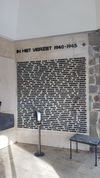

|
|
|
|
|
|
right wall, row 18 #03

Limburg 1940-1945,
Main Menu
The fallen resistance people in Limburg
Nicolaas Egidius Erkens (Nic "van der Maas")
∗ 10-10-1894 Maastricht † 09-10-1943 Fort Rhijnauwen (prov. Utrecht (48)
- Initial resistance - Erkens Group - Maastricht - Sittard - Intelligence -
- Biografieën Nic Erkens:
1. https://nl.wikipedia.org/wiki/Nic_Erkens
2. maastrichtsegevelstenen.nl + foto
3. wo2slachtoffers.nl
4. Nicolaas Erkens – Robermont Cemetery, Liege, Belgium & Resistance Group Erkens - Archief Oorlogsgravenstichting (@ Nationaal archief), Dossier Nic Erkens • #2 • #13
- Dr. F. Cammaert, Het Verborgen Front – Geschiedenis van de georganiseerde illegaliteit in de provincie Limburg tijdens de Tweede Wereldoorlog. Doctorale scriptie 1994, Groningen
2. De eerste militair-civiele verzetsformaties, pp 75-94 De groep-Erkens. - Clarence, Wikipedia • Nederlands • Deutsch • English • Français
- nl.wikipedia.org Fort Rijnauwen, Bunnik
- Bronzen Leeuw, Wikipedia • Nederlands • Deutsch • English • Français • Italiano
- fr.wikipedia.org Cimetière de Robermont Rue de Herve 46, B-4020 Liège
- Erelijst 1940-1945
- Oorlogsgravenstichting.nl
During the First World War, Nic Erkens too had been mobilized and at the end he was discharged as an officer. Between the wars, he worked at the Hustinx tube company in Liège, where he met his future wife, Bertha Josephina Maria Francisca Hustinx (∗ April 23, 1886 in Lanaken) [1.1].
After all, he must have had an important function there, because in his file at the OGS [2#2] he is referred to as an industrialist.
Because of the threat of war, Dutch conscripts were mobilized again before the Second World War; Nic also had to go. Perhaps because of his business knowledge and experience, he was transferred to the Intendancy by the Dutch army command:
During the mobilization, First Lieutenant Erkens was assigned as adjutant to the stage Intendancy in Rotterdam, an army unit responsible for supplies with the exception of armaments. Erkens retained his position after the capitulation. The intendancy was placed under German supervision and was responsible for the liquidation of army supplies such as clothing and equipment. At the end of 1940, the work related to this was completed and the occupying power dissolved the intendancy. Erkens had used the months in between to embezzle considerable quantities of the stocks together with trusted individuals from this army unit and store them with private individuals, in the sheds of acquaintances in Rotterdam and in seed bunkers in Hillegom. [3]
This was the beginning of his resistance career. When people from this network had to go into hiding or flee the country, he began to focus his activities more on this area, using his contacts in and around Maastricht and Liège. This is how the Group Erkens came into being. He became the organizer of cross-border resistance via Eijsden to Belgium, especially in the field of smuggling refugees, but also of intelligence information that was passed on to Belgian intelligence groups such as Clarence. [4]
But he himself was also soon wanted. The last Dutch address at which he was registered (Rotterdam) was no longer in use.
Cammaert [3] writes on pages 85 and 87 that Nic had two sisters in Sittard, where he had also gone into hiding for a while and where he was arrested on November 11, 1942. This happened as a result of the Hannibalspiel (Hannibal game), an infiltration of the Marineabwehr (counterintelligence of the German navy) in Groningen. The entire group in Eijsden, as well as the group in Belgium, was arrested. It was an early resistance in which Erkens and his Liège partner Arthur Renkin made errors of judgment on a personal level, which later occurred less frequently.
Of those arrested, Erkens in particular was severely tortured by the sadist Nitsch of the Maastricht security police in the hope of finding out something other than what was already known through the infiltrators anyway.
He and his companions were sentenced to death in Utrecht and shot at the execution site in Fort Rijnauwen in Bunnik. [5]
A summary of his activities can be found in document [1.2], which is part of the posthumous decoration Bronzen Leeuw (Bronze Lion). [6]
His ashes were initially taken by the Germans to the main cemetery in Erfurt.
Finally, he was buried on the “lawn of honor” (Pelouse d’honneur) of the Robermont cemetery in Liège. [7]
There appear to have been discrepancies regarding the gravestone. Originally, it bore a Belgian flag and the words "mort pour la Belgique", among others. Later, it became a Dutch flag and "mort pour les Pays-Bas", i.e. died for the Netherlands. [2#13]
Both are not quite correct: he died for freedom, by working together across national borders. Like almost all members of his group, he was active in both countries.
This person is listed in the “Erelijst 1940-1945” (Honor Roll of the Dutch Parliament). [8]
Footnotes
